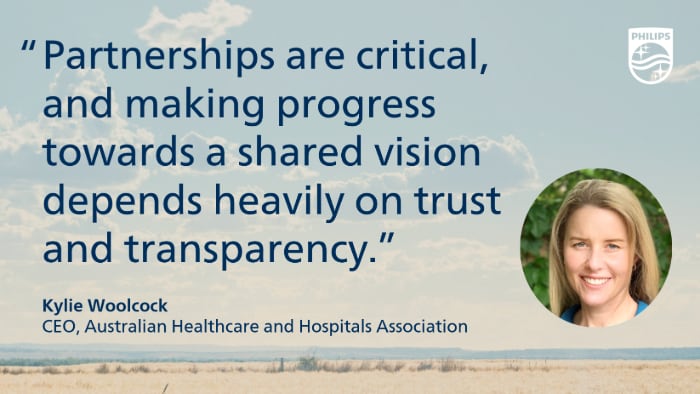Australia’s healthcare sector is one of the largest per capita carbon emitters in the world. The sector contributes an estimated 24,484 kilotonnes of carbon dioxide equivalent (kt CO2-e) emissions annually, equivalent to 5.3% of Australia’s total carbon emissions. [1] This underscores the urgent need to prioritise sustainability within Australia's healthcare system to mitigate climate change impacts and ensure our communities’ long-term health and climate resilience.

On the occasion of Zero Emissions Day on 21 September, we revisit the insights shared during our virtual panel of international healthcare leaders for Philips and the Committee for Economic Development of Australia (CEDA) that shed light on what it will take to build sustainability into Australia’s healthcare system. “There is a deep connection between environmental health and human health,” said Olesya Struk, Senior Director Group Sustainability, Philips, who moderated the panel. This sentiment is already held by most Australians, with our recent research showing that a majority understand the importance of sustainability in health. Results from Philips Sustainable Healthcare Survey show most Australians (79%) believe climate change directly impacts their health. An even greater number (90%) think more needs to be done to make healthcare more sustainable. Indeed, sustainability aligns with health system imperatives. It provides an additional lens to view many of the challenges the health system is facing, according to the panel. Three major themes emerged as key tenets to a sustainable healthcare system for Australia: innovation, leadership and collaboration.
#1: Innovation Sustainability is about waste reduction in all its forms, including time, energy and research. Low-value care, such as duplicated or unnecessary procedures, significantly contributes to carbon emissions. Minimising such low-value care can consequently minimise emissions, and key to identifying low-value care is to track and measure the right data.
Data-driven innovation reduces low-value care and increases value-based care
Australia is already making significant progress in identifying low- or no-value care. This includes research groups that examine overdiagnosis and overtreatment, and clinical quality registries. Data analysis at individual, organisational, state and agency levels is also helping to identify low-value care.
“Reducing low-value care is an obvious way to reduce emissions,” said Kylie Woolcock, Chief Executive Officer of the Australian Healthcare and Hospitals Association. “Estimates suggest about 60% of healthcare delivered is in line with guidelines. So, 30% of care is wasteful, duplicated or low value. The final 10% is care that leads to harm. [2]”
A data-driven approach is essential to accelerate the adoption and provision of high-value healthcare. Ten years ago, Finland’s Tays Heart Hospital began paying attention to value-based healthcare and that data management is key.
“If you don’t have the data, you simply can’t build value-based care models,” said panellist Aki Haukilahti, Vice President, Heart Hospital – Tampere University Hospital.
Digital innovation enables environmentally conscious care delivery

Philips’ research indicates more than 85% of Australians think technology is critical to driving environmental sustainability in healthcare delivery, a sentiment with which experts on the panel agreed.
“Increasing the use of digital care services is one way we can more efficiently provide services, while considering the environmental impact,” said Aki. “For example, our pacemaker patients are now remotely monitored, and we have over 8,000 patients on pacemaker therapy in remote follow-ups. This halves the hospital visits for this patient group and the carbon footprint of these operations.”
Design innovation embeds resource efficiency into existing practice
“What we learned from the UK National Health Service experience was that 60% of emissions are estimated to come from clinical care. [3] That figure is higher in Australia, with clinical care producing 80% of carbon emissions. [4] We really need to focus on how we design care pathways,” according to Kylie. “We need to see environmental sustainability embedded in that design of care.”
Clinical care in Australia involves the care patients are offered by clinicians and healthcare services for a specific clinical condition, treatment, procedure or clinical pathway. [5] Given that clinical care accounts for a significant portion of healthcare-related emissions, sustainability must be considered not only in care delivery, but also in the development of the technology solutions and services that support it. On average, 80% of a product’s total environmental impact is determined in the design phase. [6] Philips recognises this, and takes a holistic approach to product development and design – known as EcoDesign – which optimises the balance between sustainability, quality and user experience, to minimise our environmental impact. [7]
For instance, in May 2024, Philips marked 1.9 million litres of helium saved from its helium-free MRI operations worldwide due to its BlueSeal 1.5T magnet. [8] A conventional MRI scanner requires up to 1700 litres of liquid helium, much of which can be lost if the magnet is periodically shut down. [9] In contrast, Philips BlueSeal magnet only requires a pre-load of 7 litres during manufacturing and retains all of it, even during a sudden loss of superconductivity. This resource efficiency is one way to minimise the environmental footprint of clinical care.
#2: Leadership Empower staff to act on sustainability values
Recognising the value healthcare staff place on sustainability is vital, as staff prefer working in organisations aligned with their values. Consequently, sustainable healthcare becomes a key issue for recruitment and retention, as shared by Angie Bone, Associate Professor, Monash Sustainable Development Institute.
“Creating an environment for our workforce to do what they do well is important, as well as giving people the space to fail and to innovate. It’s powerful when we share stories about what works and what doesn’t, so others can learn.”
Embed sustainability into organisational culture

Ongoing feedback shows staff expect healthcare leaders to prioritise sustainability, with the panellists agreeing that leaders must demonstrate a genuine commitment, ensuring it translates into practice so that it does not lead to disillusionment.
“This is why in Philips, we embed sustainability across our businesses. It’s not a separate sustainability strategy, but a vision and commitment,” Olesya said.
This aspect is becoming more and more crucial, given the growing expectations on organisations at large, not just in healthcare, to disclose their carbon emissions. [10]
“Increasingly, we’re going to have to start disclosing our climate risk and the actions we’re taking to address those,” Angie said.
Ask the right questions to initiate change
Nothing changes if nothing changes. Given the responsibility in setting direction and planning ahead, healthcare leaders must reflect on a few hard questions if they are serious about building sustainability into and across their organisations, according to the panel:
#3: Collaboration Leverage on legislation to build bridges Forming partnerships across healthcare is key to embedding sustainability into care delivery, and legislation and regulation are a good starting point from which to build these connections. Trust and transparency paramount to progress
“When it comes to sustainability, we have thousands of flowers blooming across the health system of fragmented but excellent approaches. We're trying to improve this and that's what's so great about the National Health and Climate Strategy. We now have an overarching umbrella we can work under to achieve better outcomes for patients, populations and staff,” Angie said.
Australia’s National Health and Climate Strategy represents a shift in Australia’s climate policy, focussing on creating a sustainable, resilient healthcare system and building healthy, climate-resilient communities. [11] It highlights the urgency of integrating climate considerations into health governance and emphasises the need for funding to implement these critical changes effectively. [12]

While a shared vision in the healthcare sector across sustainability and technology is essential, managing the imbalance of information and expertise across myriad stakeholders is crucial to ensure a practical realisation of shared ideals. According to Kylie, “This ensures that there’s transparency in decision-making, and that we’ve got the right data to make sure we are actually progressing towards shared goals. That’s very dependent on trust between partners.” An interesting suggestion from Angie was to seriously explore having dedicated people whose role is to integrate between organizations. These dedicated integrators would possess the necessary expertise to bring together different disciplines across research, policy and practice. Share best practices to amplify real-life impact The panel also canvassed a great example of collaboration in action: the joint sustainability analysis Philips undertook with Heart Hospital – Tampere University Hospital across supply chains, medical equipment and clinical operations in Finland. The analysis provided a baseline carbon footprint for Heart Hospital’s interventional cardiology service. “We did that analysis to understand where we are now, the way forward and the lowest hanging fruits,” Aki said. “It was really eye-opening.” The results showed that each coronary procedure at Heart Hospital generated 20 kilograms of carbon emissions from the supply chain and consumables, 10 kilograms from waste and one kilogram from operations and energy consumption. These insights enabled Heart Hospital to focus its sustainability efforts on reducing emissions in patient care pathways, materials use, and clinical operations. Opportunities identified included optimising patient throughput, improving equipment utilisation, reducing inbound airfreight, reducing waste, and improving waste separation. The way forward: An incredible coordination of interventions Momentum for sustainable healthcare in Australia has significantly increased, but we are just at the take-off point. The entire healthcare system must continue working together to accelerate interventions and drive sustainability from end-to-end. “Accelerating sustainability is a challenge we need to face together across research, policy and practice,” said Kylie. Struk is optimistic: “I feel excited to collaborate with, and support, healthcare leaders in Australia to develop a more sustainable healthcare sector. It is our partnerships across the value chain that will lead to success in this space.” While current efforts to enhance sustainability in healthcare are welcome and exciting, it is essential to go beyond merely optimising and stabilising the current system and improving existing practices. “My concern is that as climate change progresses, we are going to need to go through a massive transformation – and we can either do that in a planned way or wait until the situation gets so bad that we have no choice – I know which one I’d prefer,” said Angie.
References [1] Analysis based on unpublished data provided by the Australian Department of Climate Change, Energy, the Environment and Water (DCCEEAW). National Climate and Health Strategy, Pages 45, 53-54: https://www.health.gov.au/sites/default/files/2023-12/national-health-and-climate-strategy.pdf
[2] Barratt et al, 2022, “High value care is low carbon health care”: https://pubmed.ncbi.nlm.nih.gov/34699070/
[3] NHS data: https://www.fph.org.uk/media/3126/k9-fph-sig-nhs-carbon-footprint-final.pdf#:~:text=URL%3A%20https%3A%2F%2Fwww.fph.org.uk%2Fmedia%2F3126%2Fk9
[4] Barratt et al, 2022, “High value care is low carbon health care”: https://pubmed.ncbi.nlm.nih.gov/34699070/
[5] https://www.safetyandquality.gov.au/standards/clinical-care-standards/about
[6] https://www.philips.com/a-w/about/news/archive/blogs/innovation-matters/2020/20200729-demystifying-ecodesign-and-the-impact-when-we-get-it-right.html
[7] https://www.philips.com.au/a-w/about/environmental-social-governance.html
[8] https://www.philips.com/a-w/about/news/archive/standard/news/press/2024/philips-celebrates-1-9m-liters-of-helium-saved-as-it-marks-1111-helium-free-mri-operations-installs.html
[9] https://www.philips.com/a-w/about/news/archive/standard/news/press/2024/philips-celebrates-1-9m-liters-of-helium-saved-as-it-marks-1111-helium-free-mri-operations-installs.html
[10] https://www.finance.gov.au/government/climate-action-government-operations/commonwealth-climate-disclosure#:~:text=Commonwealth%20Climate%20Disclosure%20is%20the,their%20actions%20to%20manage%20them.
[11] https://www.caha.org.au/mr_031223
[12] https://www.caha.org.au/mr_031223
Share on social media
Topics
Contacts

Yi Xian, Tan Brand & Communications Manager Philips Australia & New Zealand
You are about to visit a Philips global content page
Continue












